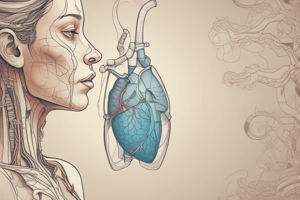Podcast
Questions and Answers
How does positive-pressure ventilation affect cardiac output?
How does positive-pressure ventilation affect cardiac output?
It increases intrathoracic pressure, which decreases venous return to the heart and causes a decrease in cardiac output.
Which of the following structures is NOT found in the upper airway?
Which of the following structures is NOT found in the upper airway?
- Bronchus (correct)
- Nasal cavity
- Larynx
- Pharynx
Each cell of the body combines nutrients and oxygen and produces energy and waste products through a process called:
Each cell of the body combines nutrients and oxygen and produces energy and waste products through a process called:
metabolism.
The process of exchanging oxygen and carbon dioxide between the alveoli and the blood of the capillaries is called:
The process of exchanging oxygen and carbon dioxide between the alveoli and the blood of the capillaries is called:
Which of the following is the MOST reliable indicator of adequately performed bag-mask ventilations in an apneic adult with a pulse?
Which of the following is the MOST reliable indicator of adequately performed bag-mask ventilations in an apneic adult with a pulse?
Oxygen and carbon dioxide diffuse across the alveolar walls and capillaries.
Oxygen and carbon dioxide diffuse across the alveolar walls and capillaries.
Hypoxia is MOST accurately defined as:
Hypoxia is MOST accurately defined as:
What should you do if you have inserted an oral airway and the patient begins regurgitating large amounts of vomit?
What should you do if you have inserted an oral airway and the patient begins regurgitating large amounts of vomit?
What must the EMT do for a semiconscious patient with vomitus on his face and slow, shallow respirations?
What must the EMT do for a semiconscious patient with vomitus on his face and slow, shallow respirations?
Tidal volume is defined as the volume of air that:
Tidal volume is defined as the volume of air that:
What is the primary waste product of aerobic metabolism?
What is the primary waste product of aerobic metabolism?
Which of the following patients would MOST likely require insertion of an oropharyngeal airway?
Which of the following patients would MOST likely require insertion of an oropharyngeal airway?
Structures of the lower airway include all of the following, EXCEPT:
Structures of the lower airway include all of the following, EXCEPT:
The nasopharyngeal airway is MOST beneficial because it:
The nasopharyngeal airway is MOST beneficial because it:
Prior to applying a nonrebreathing mask on a patient, you must ensure that the:
Prior to applying a nonrebreathing mask on a patient, you must ensure that the:
An oxygen cylinder should be taken out of service and refilled when the pressure inside it is less than:
An oxygen cylinder should be taken out of service and refilled when the pressure inside it is less than:
CPAP is indicated for patients who:
CPAP is indicated for patients who:
How does CPAP improve oxygenation and ventilation in patients with certain respiratory problems?
How does CPAP improve oxygenation and ventilation in patients with certain respiratory problems?
What is the MOST appropriate treatment for an adult conscious and alert patient with a foreign body airway obstruction who is coughing forcefully?
What is the MOST appropriate treatment for an adult conscious and alert patient with a foreign body airway obstruction who is coughing forcefully?
What is the MOST serious complication associated with using a nasopharyngeal airway in a patient with trauma to the head or face?
What is the MOST serious complication associated with using a nasopharyngeal airway in a patient with trauma to the head or face?
Flashcards are hidden until you start studying
Study Notes
Positive-Pressure Ventilation
- Increases intrathoracic pressure, leading to decreased venous return to the heart.
- Results in a reduction of cardiac output.
Upper Airway Structures
- The bronchus is NOT a component of the upper airway.
Metabolism
- The process by which cells utilize nutrients and oxygen to produce energy and waste products.
External Respiration
- Involves the exchange of oxygen and carbon dioxide between alveoli and capillary blood.
Bag-Mask Ventilations
- The most reliable indicator of proper bag-mask ventilation is the adequate rise of the chest upon squeezing the bag.
Gas Exchange in the Lungs
- Normal gas exchange occurs as oxygen and carbon dioxide diffuse across alveolar and capillary walls.
Hypoxia
- Defined as insufficient oxygen supply to tissues and cells.
Managing Regurgitation During Ventilation
- If a patient begins to vomit during ventilation, roll them onto their side and remove the oral airway.
Oropharyngeal Suctioning
- Essential for a semiconscious patient with slow, shallow respirations and vomitus present.
Tidal Volume
- Refers to the volume of air that moves in and out of the lungs during a single breath.
Aerobic Metabolism Waste Product
- Carbon dioxide is the primary waste produced during aerobic metabolism.
Oropharyngeal Airway Usage
- Indicated for unconscious patients with slow, shallow respirations.
Lower Airway Components
- The epiglottis is NOT part of the lower airway.
Nasopharyngeal Airway Benefits
- Effectively maintains a patent airway in semiconscious patients who have a gag reflex.
Nonrebreathing Mask Preparation
- Ensure the reservoir bag is fully inflated before application on a patient.
Oxygen Cylinder Refilling
- A cylinder should be refilled when the pressure drops below 500 psi.
Continuous Positive Airway Pressure (CPAP)
- Indicated for patients with pulmonary edema who can follow verbal commands.
CPAP Functionality
- Improves oxygenation and ventilation by forcing open the alveoli and enhancing oxygen transfer across the alveolar membrane.
Foreign Body Airway Obstruction
- In a conscious patient who is coughing forcefully, the best approach is to encourage coughing and ensure safe transport.
Nasopharyngeal Airway Complications
- The most serious risk with its use in trauma cases to the head or face is the potential to penetrate the cranium.
Studying That Suits You
Use AI to generate personalized quizzes and flashcards to suit your learning preferences.




